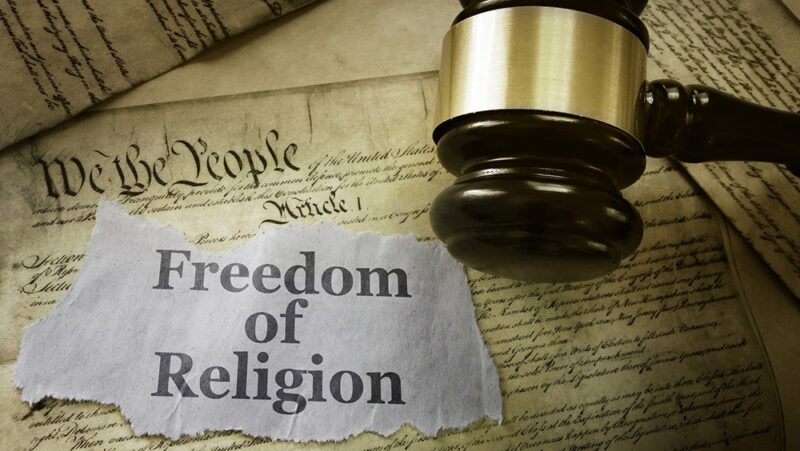Is Clothing Protected by the First Amendment?

Clothing is much more than just a functional way to stay warm or protected from the elements. Clothes can be used to express yourself, to show what you believe, to support a team or to send a message.
But can you wear whatever you want, wherever you want? Does it matter who you are, where you are or what the clothing in question is?
Is clothing protected by the First Amendment?
Overall, yes, expressive clothing choices are protected by the First Amendment as free speech – with some exceptions.
The First Amendment protects free speech. More broadly, it protects sending a message by saying something with words or symbols on clothing in addition to spoken words. But as with all First Amendment rights, it’s not unlimited.
The First Amendment only prevents the government – not private people or companies – from limiting speech on clothing. And even the government can sometimes limit clothing if the clothing is unprotected speech or if a limit is required to protect safety or other key government functions.
Is clothing protected in public places?
In general, clothing choices are protected when you are walking down the street or in another public space like a city park or beach, or on public transportation.
Protections for clothing in public
The U.S. Supreme Court said in 1971 that clothing with offensive or profane speech is protected by the First Amendment. It overturned the conviction of Paul Robert Cohen, who wore a jacket with the words “(Expletive) the Draft” (the expletive was spelled out) into a California courthouse. The 5-4 ruling said that the message on the jacket was neither obscene nor “fighting words,” an unprotected type of speech intended to provoke violence. It wasn’t targeted specifically at anyone, and anyone offended by the message could turn away.
In January 2023, a group of South Carolina Catholic school students visiting the government-run Smithsonian National Air and Space Museum in Washington, D.C., were asked to remove hats with “Rosary Pro-Life” text on them or leave the museum. The students sued for free speech and religious freedom violations. The government cannot ban clothing just because it does not like the message. Any limits on clothing must be regardless of the point of view it expresses. The museum settled the lawsuit out of court, agreeing to pay the students money and retrain staff about policies for guests’ clothing.
Limits on clothing in public
Some cities and states have laws to limit wearing masks in public or in stores. Such laws are not about limiting any expressive element of wearing a mask, but rather aim to protect public safety and prevent crimes where perpetrators cannot be identified. But these laws are often enforced against protestors who wish to remain anonymous, which is targeting particular speakers and can infringe on the right to anonymous protest. Ultimately, the burden is on the government to show that the reason for the restriction is unrelated to the speaker or the type of speech and instead necessary to protect public safety. The government also must demonstrate that the restriction will achieve that goal while still allowing speech and expression to occur.
Laws against masks have exceptions in some cities and states to enable wearing masks in public for health reasons.
In the late 1800s and early 1900s, many city and state laws made cross-dressing illegal, therefore barring people from dressing in clothing contrary to gender norms. Similarly, masquerade laws made it illegal to wear someone else’s clothing in public for illegal purposes. They aimed to cut down on disguises worn by illegal gambling rings. Such laws became harder to enforce as fashions and clothing norms changed, but some remained technically on the books until as recently as 2011.
In recent years, new laws to limit drag performances aim to regulate who can host or attend drag performances, rather than what can be worn, but the laws can limit drag attire. Tennessee and Texas laws to regulate drag have been struck down in court as vague or as discriminating based on viewpoint because they apply only to drag but not to other types of performances. However, in a separate case over a proposed drag show at West Texas A&M University, a judge upheld limits on a drag performance, ruling that drag is not clearly expressive conduct.
RELATED: Everything to know about drag and the First Amendment
A lack of clothing can be illegal. Indecent exposure or public indecency laws in most states make public nudity illegal to varying degrees.
Is clothing protected in restaurants, stores or malls?
Clothing is not protected by the First Amendment from limits imposed by the owners of restaurants, stores or other privately owned places of business. In publicly accessible but privately owned spaces, establishments can set their own policies for customers and employees.
Sometimes the government can step in to limit private companies’ clothing rules.
Employers cannot prevent their employees from organizing or advocating for unions or for advocating for improved working conditions for everyone, as long as the speech is not profane.
In December 2023 and in March 2024, courts ruled that two separate Starbucks locations in New York and Seattle should not have limited how their employees wore or distributed union buttons at work.

Pro-union pins on a table during a watch party in New York for Starbucks' employee union election in 2021.
In February 2024, the National Labor Relations Board said that Home Depot could not ban employees from wearing Black Lives Matter buttons. It pointed to the National Labor Relations Act, which says that businesses cannot restrict employee speech that is designed to improve workplace conditions for everyone and is not profane or insulting.
Businesses also cannot discriminate against people based on a protected class, defined as race, religion, sex and disability, depending on the applicable law. That means they cannot ban clothing with the intent or effect of specifically impacting people based on a protected characteristic.
In 2015, the Supreme Court ruled against clothing retailer Abercrombie & Fitch for rejecting a job applicant who wore a religious headscarf. The store’s dress code banned employees from wearing head coverings, but the court ruled that refusing to hire the applicant because of her hijab was discriminating against her based on her religion.
Is clothing protected in schools?
Students in public schools have free speech rights, though schools do have some leeway to regulate student speech in the interest of protecting a safe learning environment.
Private schools, like businesses and employers, are not bound by the First Amendment.
Protections for public school student clothing
Student speech was firmly protected by the Supreme Court when it ruled in Tinker v. Des Moines Independent Community School District (1969) that public school officials should not have punished three students for wearing black armbands to protest the Vietnam War. The court said that public schools may not prevent or punish student expression unless they can reasonably predict that it will cause a “substantial disruption” of class or intrude on other students’ rights.

Mary Beth Tinker, in 2013, showing an old photo of her with her brother John Tinker.
In 2003, a court ruled that a Virginia middle school’s ban on clothing with images of weapons was too restrictive and not necessary to keep the school functioning safely. A student had sued after being required to stop wearing a National Rifle Association T-shirt.
An Oklahoma school district in 2004 settled a lawsuit brought by 11-year-old Nashala Hearn, who was ordered to remove her hijab. The school had a dress code prohibiting hats and head coverings, but allowed some exceptions, including for Hearn. Then the school changed its mind and told her she could no longer wear her hijab, suspending her when she refused to take it off. The U.S. Department of Justice sued the school district for discriminating and interfering with her right to exercise her religion by wearing a hijab. The district settled the case by agreeing to allow the hijab and religious accommodations for other students.
The same year, a Kentucky high school refused to allow student Jacqueline Duty to attend prom wearing a dress decorated as the Confederate battle flag. The student and school later ended the case on their own outside of court.
A year later, a federal judge ruled in favor of a West Virginia student’s right to wear Confederate flag clothing, ruling that the clothing did not cause any disruption. However, a court in 2008 said a Tennessee high school’s ban on Confederate flag clothing and symbols was OK because the school had been disrupted and required police to be stationed at the school due to racial tensions.
Limits on student clothing
Public schools may not prevent or punish students’ clothing just because it has messages the school may not agree with. But schools may limit clothing that disrupts class or infringes on the rights of other students.
In June 2024, a court ruled that a Massachusetts school can ban a T-shirt reading “There are only two genders.” The boy who wore the shirt claimed the school violated his First Amendment free speech rights. The school said that the shirt demeaned trans and nonbinary students, violating their right to a safe school environment. The court deferred to the school. In October 2024, he asked the Supreme Court to hear his case.
Lawyers for a Middleborough middle school student who was barred last year from wearing a shirt to class that said “There are only two genders” have petitioned the US Supreme Court to hear the First Amendment case after an appeals court sided against him. https://t.co/SQnqsFW7X9
— The Boston Globe (@BostonGlobe) October 10, 2024
Schools may have dress codes that limit clothing for reasons unrelated to the message. For example, hats can be banned for safety and security reasons, if schools accommodate religious head coverings. Courts have ruled that schools can ban saggy pants that are more of a behavior than sending a message. And schools do have leeway to limit vulgar speech and profanity.
Private schools have the most leeway to regulate student clothing because they are not bound by the First Amendment.
What's the bottom line on clothing and the First Amendment?
Dressing to send a message is protected from most government regulation unless its message fits a category of unprotected speech or meets a high bar for being regulated.
When the clothing isn’t sending a message, it may be easier for the government to limit it. And if required to protect health, safety, or education, a limit on clothing may be OK if it allows as much speech as possible and does not discriminate based on the clothing’s message.
Dress up or dress down. Dress according to your religious beliefs or to support your favorite sports team. Show off your viewpoints and your style. Know the rules at work and school and know that there’s a high bar to the government imposing on your fashion sense.
U.S. Journalist Evan Gershkovich Marks One Year of Imprisonment in Russia
13 Freedom of Religion Quotes You Should Know
Related Content
Religion. Speech. Press. Assembly. Petition.
Learn about the First Amendment.

